Quasimodo Trading Strategy – Spot Reversal patterns in 2023
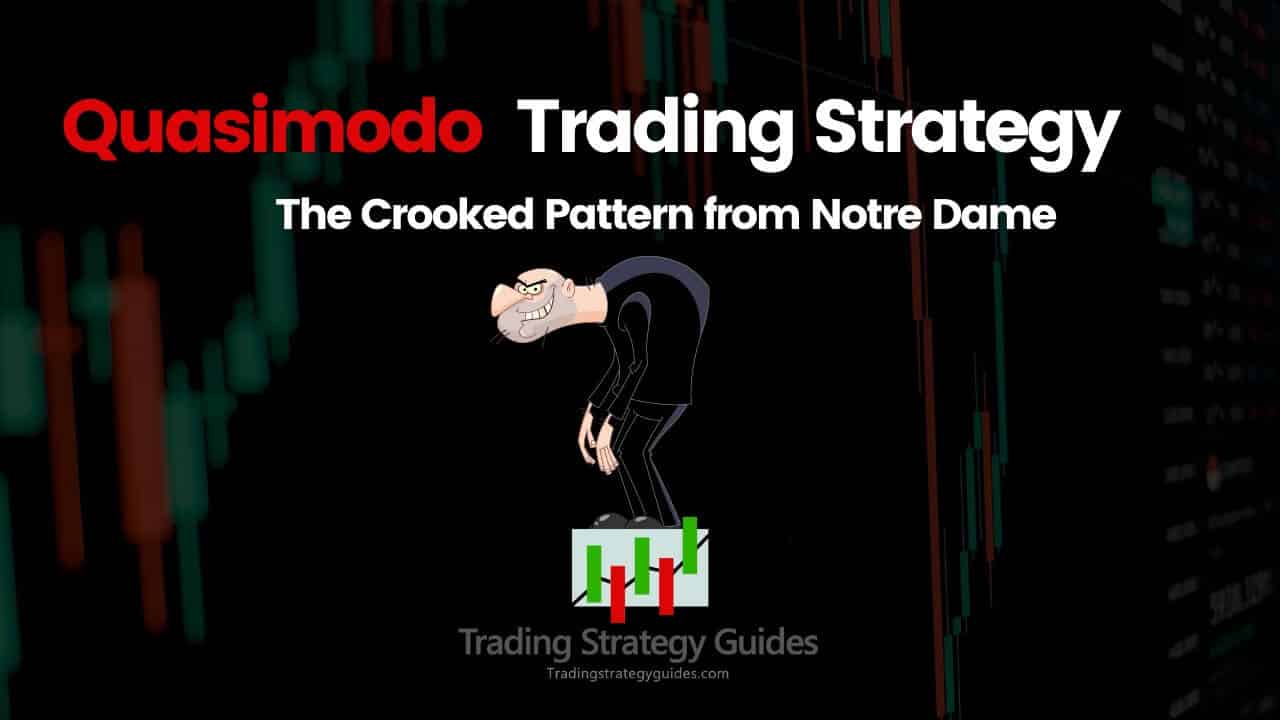
Learn the Quasimodo pattern trading strategy to find profitable trend-reversal opportunities. Throughout this trading guide, you’ll learn what is Quasimodo pattern trading, how to spot this reversal setup, what are the similarities between the Quasimodo Pattern Trading Strategy and Head and Shoulder trading, and, last, but not least, we’re going to have a deep dive into how to create a winning trading strategy.
If this is your first time on our website, our team at Trading Strategy Guides welcomes you. We want every trader to be successful, so if you need somewhere to get started, check out our beginner’s guide to trading the markets.
Also, if you want to browse our content, we have some wonderful trading guides you need to check out to get up to speed:
For those new to trading altogether we highly recommend What is Trading, a comprehensive trading guide to understand the basics, and to help new traders make smart decisions starting out.
For those new to Forex Trading, we believe that Tradings Strategy Guides has the best beginner Forex Guide out there. Learn everything you need to know to get a leg up in Forex Trading.
Trading is not an easy game, but with the Quasimodo pattern trading setup you can gain some valuable insight into that market sentiment, more precisely, you will know in advance when the trend is about to reverse. By being able to stay ahead of the market, you can increase the accuracy of your trading strategy and improve your expected return on investment (ROI).
Get Our Free Swing Trading Report Today!
- Entry Points
- Exit Points
- Risk Managament
- Time Saving Tips
This article talks about reversals in more depth: Trend Reversals in Forex and How to Anticipate Them.
If this sounds interesting, let’s start by explaining what the Quasimodo strategy is.
What is The Quasimodo Trading Strategy?
Quasimodo strategy is a reversal trading pattern that appears at the end of an uptrend. As a price formation, the Quasimodo pattern is depicted by three peaks and two valleys, where:
- First, the middle peak is the highest, while the outside two peaks are of the same height.
- And secondly, the second valley is lower than the first one.
Note* Some technicians might call this reversal pattern the “Over and Under” chart pattern.
The figure below outlines the Quasimodo strategy chart pattern:

Quasimodo pattern in forex trading predicts a bullish-to-bearish trend reversal.
Based on the analogy of market sentiment we can distinguish two types of Quasimodo patterns:
- Bullish Quasimodo, which appears at the end of a downtrend.
- Bearish Quasimodo, which appears at the end of an uptrend.

Now, you might be inclined to believe that the Quasimodo pattern looks similar to the Head and Shoulder trading pattern.
You’re not mistaken as the two trading chart patterns are related but at the same time, they are distinguished price formations.
Below, we’re going to expand on the differences between Quasimodo trading vs. Head and Shoulder trading.
Differences between Quasimodo Strategy and Head and Shoulder
There are two major differences between the Quasimodo pattern trading and Head and Shoulder trading:
- The valleys have different price structures – aka the depth of the valleys have no symmetry with the Quasimodo pattern.
- And, the two reversal patterns use two different entry techniques.

The main difference between the Quasimodo pattern and the Head and Shoulder pattern is the left leg (second valley) of Quasimodo is much lower than the right leg (first valley). With the Head and Shoulder pattern, both valleys are more or less of the same scale.
The Quasimodo price structure doesn’t stand out compared to the HS pattern.
That’s where the Quasimodo name is derived from – aka the “malformed” second valley, which depicts a crooked Head and Shoulder pattern.
In this regard, it’s not going to be that easy to identify with your naked eye the Quasimodo forex chart pattern. Instead, you’ll need to use advanced trading indicators.
The second major difference between the two reversal patterns is the point of entry.
Usually, the point of entry for the HS pattern is the break of the neckline, but with the Quasimodo pattern, we put an entry order near the left shoulder.

Basically, Quasimodo is an advanced pattern of Head and Shoulder.
A key question that is asked by many traders is how we determine when to trade the Quasimodo chart setup.
When to Trade Quasimodo Trading Setup?
The best time to trade the Quasimodo pattern is after a significant rally or sell-off no matter the time frame used. All chart patterns are fractal in nature meaning they generally appear in various forms in different time frames from the daily chart down to the 1-minute chart. This is great news for traders who trade across multiple time frames.
The existence of the prevailing trend gives us the opportunity to either catch an entirely new trend or at least we get the chance to profit from a temporary retracement.
Additionally, the Quasimodo chart pattern allows for better entry points, which is in contrast with trend trading where the entry signals are delayed. But, as you might know, each trading style has its pros and cons.
Now, let’s see how Quasimodo pattern trading works.
How Quasimodo Pattern Trading Works?
The Quasimodo pattern works based on the imbalance between the supply and demand forces.
Or, in other words, the Quasimodo chart pattern tracks the shift in the price structure.
Market structure is the continuous series of higher highs and higher low producing higher peaks and troughs. When we have a break of structure, meaning a break of the ongoing HH and HL, the price starts first to print a lower low.

The Quasimodo trading strategy provides us with a proper framework to interpret the constant ebbs and flows of any asset (currency, cryptocurrency, stocks, commodity, etc.).
The bearish Quasimodo pattern is in short concerned with how the market comes from a buying momentum and heads towards the selling momentum.
The Quasimodo chart pattern starts to become visible only once the price fails to make another higher low (HL).
For some novice traders, this type of information might be enlightening because now you can have a proper framework to analyze the price structure. You have to keep in mind that this is one approach to viewing the markets and by no means the only one.
Now that things are starting to get clearer, we’re good to define the Quasimodo pattern trading rules
Quasimodo Pattern Trading Rules
The Quasimodo trading rules for sell signals can be summarized as follow:
-
A prevailing uptrend needs to be visible – a series of HH followed by a series of HL.
-
Break in the market structure – price starts to make lower lows LL.
-
Place a sell order near the right shoulder.
-
Hide the protective stop-loss above the last higher high HH.
-
Take profit near the first valley of the Quasimodo chart pattern.
As a general rule, the Quasimodo pattern carries more weight if the second valley is much lower than the first valley. In other words, the bigger the distance between the two valleys, the more crooked the Quasimodo pattern becomes.
The forex chart below outlines a bearish QM pattern on the 1-hour timeframe:
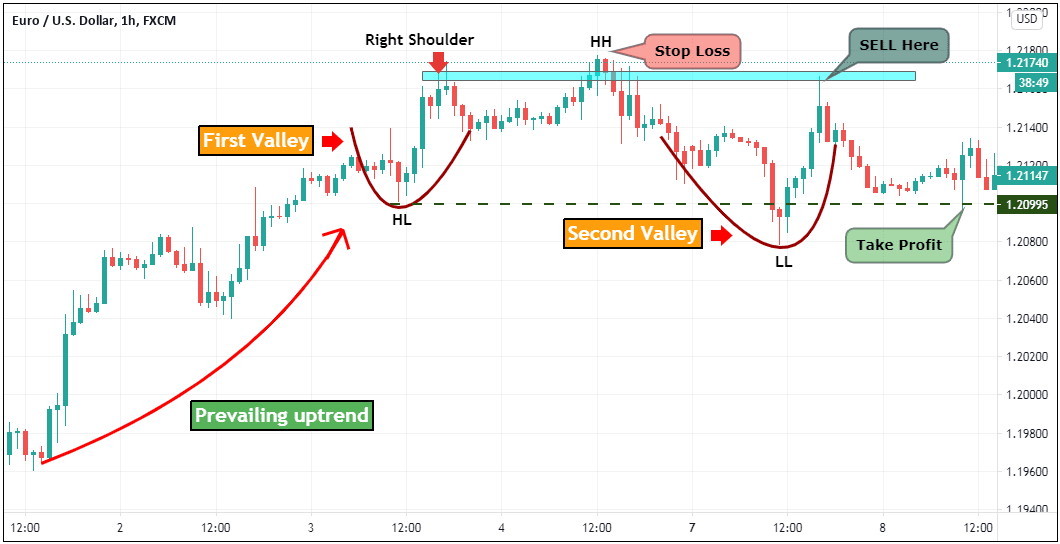
Next…
Let’s have a look at the bullish Quasimodo reversal pattern.
The Quasimodo trading rules for buy signals can be summarized as follow:
- A prevailing downtrend needs to be visible – series of LL followed by a series of LH.
- Break in the market structure – price start to make higher high HH.
- Place a buy order near the right shoulder.
- Hide the protective stop-loss strategy below the last lower low LL.
- Take profit near the first peak of the Quasimodo chart pattern.
The forex chart below outlines a bullish QM pattern on the USD/JPY 1 hour timeframe:
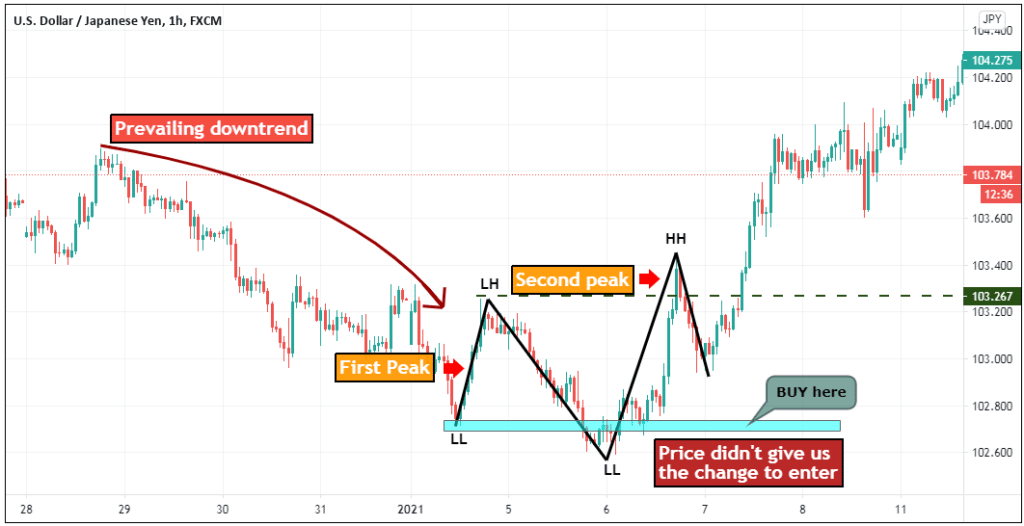
Now let me share with you a simple but effective trading trick.
If you want to test how crooked the Quasimodo chart pattern is, simply draw some lines along with the price structure. When you do this, the Quasimodo price structure will pop up on your price chart.
When you highlight the price structure (as in the USD/JPY trade example) we can clearly see the crookedness of Quasimodo.
In the USD/JPY example, we can see the price structure is not that crooked, it looks more like the Head and Shoulder pattern.
Thus, in this particular trade, the market didn’t give us the chance to enter a buy order.
And that’s the thing with the Quasimodo pattern trading, meaning lots of missed opportunities.
To go around this pitfall that is common with all chart patterns, we’re going to add some confluence to the Quasimodo pattern and twist the rules.
Below, we’re going to outline an advanced Quasimodo trading strategy:
Quasimodo Trading Strategy
You don’t have to add complicated stuff to make a simple chart pattern give more accurate trade signals. The only extra tool we need to optimize the Quasimodo trading strategy is the Fibonacci retracement indicator.
Now, if you’re a fan of the Fibonacci retracement tool, you might want to check out this new Fibonacci Trend Line Trading Strategy.
The Fibonacci retracement indicator can help us anticipate where the last price swing that is part of the Quasimodo chart pattern might end. If you backtest this pattern, you’ll see a lot of missed trading opportunities because the last swing wave of the Quasimodo pattern doesn’t always stretch near the left shoulder. If you need to learn the best backtest strategy check out our blog!
The Fibonacci retracement levels can help us identify reliable price zones of support and resistance. We’re particularly interested in the price zone between the 50% Fibonacci retracement and 61.8%, with the sweet spot being the 61.8% Fibonacci retracement level.
Now, let’s get back to our missed trade on the USD/JPY chart.
By applying the new rules of the Quasimodo trading strategy, we’re able to capture a full-blown reversal.
See the chart below:

The USD/JPY found support right between the 50% Fibonacci retracement and the golden ratio.
Another key point to take into consideration when you trade the Quasimodo pattern is the quality of the swing highs and lows.
We need to find a mechanical approach to quantify the quality of the swing highs and swing low points.
As a general rule, we consider a qualified swing high (swing low) only those points that have a V-shaped pattern. These price formations are also known as V tops and V bottoms.
A V-shaped swing low can be easily recognized by the price sharply switching from bearish to bullish respectively from bullish to bearish.
If we examine the price structure of the same USD/JPY chart and the Quasimodo chart pattern, we can notice that every single swing high and swing low part of the Quasimodo pattern is V-shaped.
See the forex chart below:

The main point to take is that when the Quasimodo price structure is V-shaped, you can bet your house on it.
Final Words – Quasimodo Pattern Trading
In summary, the Quasimodo pattern trading strategy is a new technique used to catch trend reversals. Don’t be afraid to give it a try just because it’s a new chart pattern. When all the elements of this reversal pattern come together, you have a receipt for success. With our Quasimodo pattern trading strategy, you now have a proper framework to tame the highly volatile forex market.
So, here is a quick summary of what you’ve learned today:
- Quasimodo chart pattern is a reversal pattern.
- Quasimodo trading is not similar to Head and Shoulder trading.
- Quantify the crookedness of Quasimodo by drawing a visual line on the price chart.
- The V-shaped price structure of the Quasimodo pattern produces more profitable signals.
- The 50% – 61.8% Fibonacci retracement zone is a better entry technique.
Thank you for reading!
Be sure to learn about mean reversion trading strategies, as well.
Feel free to leave any comments below, we do read them all and will respond.
Frequently Asked Questions
What is the Quasimodo pattern trading strategy?
The Quasimodo trading strategy is a price-action-based trading approach that aims to identify potential reversals in the market by looking for key levels of support and resistance. The strategy is named after the hunchback character Quasimodo from Victor Hugo’s “The Hunchback of Notre Dame,” as the price pattern resembles his hunched back.
How does the Quasimodo trading strategy work?
The Quasimodo trading strategy works by looking for price patterns that indicate a potential reversal in the market. Traders using this strategy typically look for key levels of support and resistance, along with specific price patterns like double tops and bottoms or bullish and bearish divergences.
Once a potential reversal is identified, the trader may enter a long or short position depending on the direction of the expected reversal.
What markets is the Quasimodo trading strategy best suited for?
The Quasimodo trading strategy can be applied to a variety of markets, including stocks, forex, and futures. It is particularly well-suited for markets that exhibit clear levels of support and resistance, as these are key elements of the strategy.
What are some potential benefits of using the Quasimodo trading strategy?
The Quasimodo trading strategy can help traders identify potential reversal points in the market, which can lead to profitable trades. Additionally, the strategy is based on price action and key levels of support and resistance, which can provide a solid foundation for a trading approach.
What are some potential risks of using the Quasimodo trading strategy?
Like any trading strategy, the Quasimodo trading strategy carries some risks. For example, the strategy relies on the accurate identification of key levels of support and resistance, which can be challenging in volatile or rapidly changing markets. Additionally, as with any trading approach, there is always the risk of losses when using the Quasimodo trading strategy.
How can I get started with the Quasimodo pattern trading strategy?
To get started with the Quasimodo trading strategy, you will need to familiarize yourself with key price patterns and levels of support and resistance. You may also want to use charting software that allows you to identify these elements on a price chart. Finally, you should back test and forward-test your trading strategy to ensure that it is profitable and suitable for your trading style and risk tolerance.




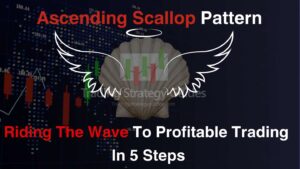
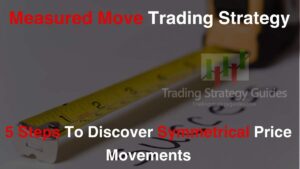


this is a nice strategy i like it
Thank you! Glad you enjoyed the strategy.
Awesome
Thank you!
where to puts SL when hits the golden ratio ? thank you
hay
Hello ????
Clement Rsa❤
Best strategy ever❤
Thank you ????
Really helpful
Glad it helped!
Perfect👍but u should explain mor examples of qm with fibonacci retracement combination and how to work it
Good strategy, but you should learn the difference between left and right.
Thanks a lot, well educative